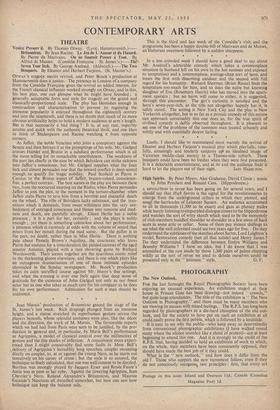PHOTOGRAPHY
The New Outlook.
FOR the last fortnight the Royal Photographic Society have been enjoying an unusual experience. An exhibition staged at their house in Princes Gate has been drawing—not indeed " crowds," but quite large attendances. The title of the exhibition is " The New Outlook in Photography," and there must be many members who are viewing its success with mixed feelings. The R.P.S. has long.been regarded by photographers as a die-hard champion of the old out- look, and for the society to have put on such an exhibition at all could easily prove the first pebble, which is followed by a landslide.
It is easy to see why the public—who keep away so determinedly from conventional photographic exhibitions (I have walked round many where the silence sounded like a shout of protest)—are at least beginning to attend this one. And it is strongly to the credit of the R.P.S. that, having decided to hold an exhibition of work to which, on the whole, their members have been consistently opposed, they should have made the best job of it they could.
What is the " new outlook," and how does it differ from the old ? Those who support the new movement follow, even if they do not consciously recognised two principles : first, that every art implies a relationship to life, and the relationship of photography is uniquely close. Photography is an immediate art. The photographer does not—or should not primarily—compose ; he selects. Interesting and delightful work is done at times by those who stage careful arrangements of objects—human and material—but this is not the true use of the camera, whose special quality it is to work to thousandths of a second.
The camera's truest use is in day-to-day contact with the rush and scurry of life, catching and making permanent that which is fleeting—sometimes indeed actually invisible—by its speed. The camera is a machine for slicing cross-sections out of space and time ; the cameraman is the seeing eye and guiding hand which cuts the right cross-sections. Working in this way, he is, of course, partly dependent upon chance. But it is no good his fighting against chance and trying to eliminate it altogether ; like the steeplechase- rider, he must learn to master and incorporate the element of luck. A first-rate cameraman has, therefore, many failures ; but the ordinary snapshotter has, in a lifetime, no successes.
The second principle of those who follow the " new outlook " is an extension of the first. Mere reproduction of a scene, however interesting or delightful, will seldom be enough. There must be present some quality of imagination to which the imagination of the visitor or viewer can respond. Where the new idea differs from the old is that supporters of the former try, on the whole, to find their imaginative spark within their subject and to elucidate it by photographic means, rather than impose it on the subject from outside.
Two striking exambles of these different methods are to be seen in this exhibition—for not all that is classed as the " new outlook " is, or could be expected to be, entirely new in idea. The first is Ergy Landau's picture of a circus horse, in which—by allowing movement fo be recorded on the negative—he has produced, not a ponderous beast but a 'Pegasus, winged and almost transparent, mounting like smoke into the air. The opposite method is shown by Zoltan Glass's picture, in which a young couple hold hands across a table while the space around them is filled with flaming



































 Previous page
Previous page